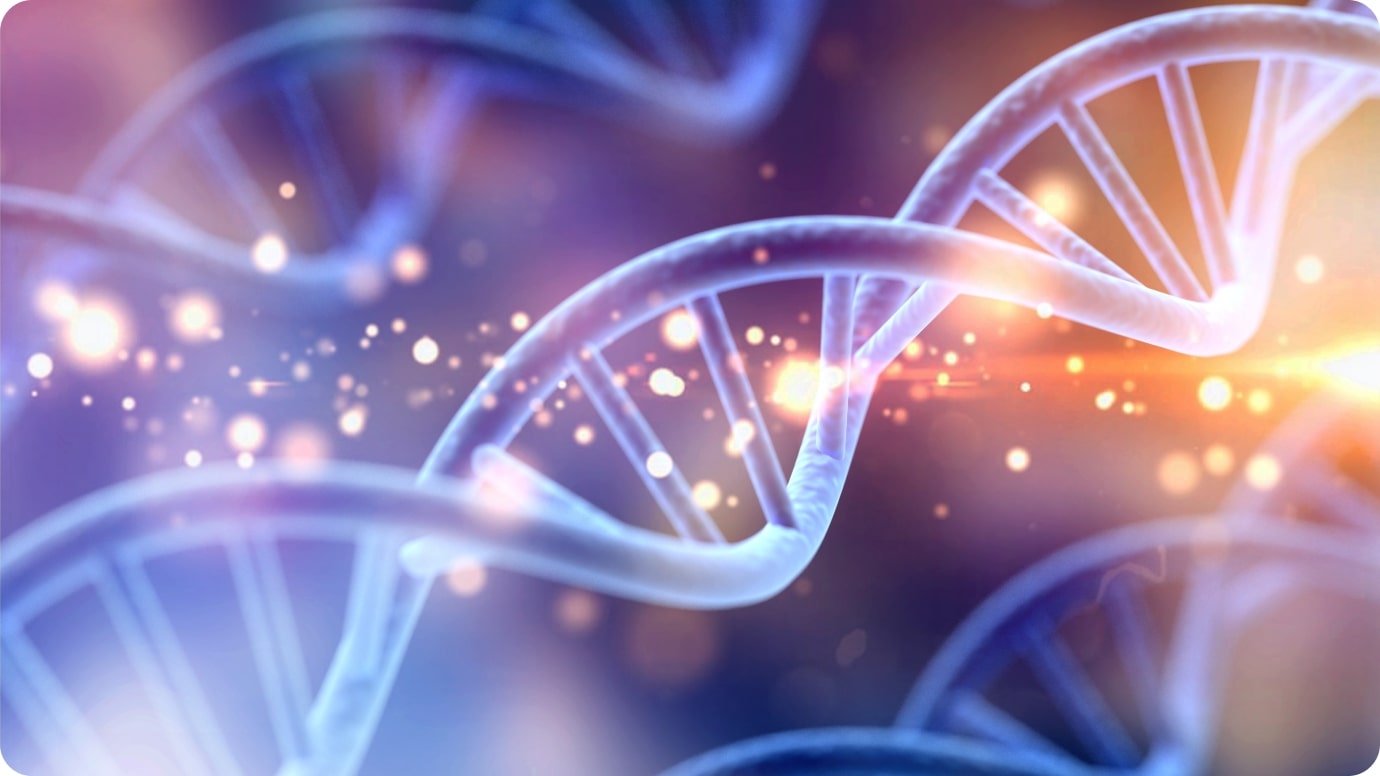
Amaha / / /
ARTICLE | 6 MIN MINS READ
Is Depression Hereditary?
Published on
26th Mar 2025

Dr Dhruva Ithal
MD Psychiatry

Explores the genetic, biological, environmental and social factors that can contribute to depression, and how strong the prevalence of family history is in a person’s susceptibility to depression.
Genetic factors influence depression, although that doesn’t imply that it’s solely hereditary. Like a lot of psychological disorders, depression can often be a result of a complex interaction of environmental and genetic reasons. Research says that genetic factors are responsible for approximately 37-48% of the risk of developing depression (Daze, 2023). This implies that environmental factors also play a significant role in depression.
Depression, or Major Depressive Disorder (MDD), is all too common but also a serious condition that can affect behaviour, mood and daily life. It’s characterised by a persistent sadness, emptiness or irritability lasting at least two weeks. Loss of interest and pleasure in activities, decreased energy levels, and increased fatigue (even with minimal exertion) are some other clear symptoms of MDD.
Also read: Sadness vs depression: How to tell the difference?
Symptoms of depression include:
- Low self-esteem and self-confidence
- Persistent feelings of guilt and worthlessness
- Bleak, pessimistic view of life and the future
- Sleep disturbances such as sleeping too little (insomnia) or too much (hypersomnia)
- Difficulty concentrating and reduced attention
- Changes in appetite (Diminished or increased)
Often, regular mood fluctuations as a response to life’s usual challenges shouldn't be mistaken for depression. It's a more severe and recurrent form and can adversely affect functioning in school, work and family settings.
Depression and genetics
While depression can be genetic and run in families, it is not only caused or influenced by genes. Various neurobiological, genetic and immune processes influence depression.
However, a positive family history is one of the main risk factors for depression. Having a parent or sibling with major depression increases your risk to 20-30%, from the general 10%.
Linkage studies suggest that specific chromosomal regions may be associated with depression. Genetic factors can differ depending on whether the disorder is familial (occurring in multiple family members) or sporadic (present in an individual with no family history). Familial cases can often have a stronger genetic link, whereas sporadic cases have a weaker genetic influence concurrent with environmental factors.
How do genetics shape depression?
Brain chemical regulation
Certain genetic variations can impact how effectively the brain utilises neurotransmitters like serotonin. When these neurotransmitters, crucial for mood regulation, are not transported efficiently, it can increase an individual's susceptibility to depression.
Similarly, variations in genes affecting dopamine and norepinephrine levels can also contribute to the development of depressive symptoms.
Stress response system
Prolonged exposure to stress can lead to an overactivation of the hypothalamic-pituitary-adrenal (HPA) axis, resulting in elevated cortisol levels. This hormonal imbalance is frequently observed in individuals with depression, and genetic factors influence how the body manages stress responses.
Neurogenesis
The process of generating new brain cells, known as neurogenesis, is vital for maintaining healthy mood regulation. Genetic factors play a role in this process, and disruptions—often related to the brain-derived neurotrophic factor (BDNF)—can increase vulnerability to depression.
Inflammatory responses
Chronic inflammation, characterised by elevated levels of cytokines, can interfere with neurotransmitter systems and neurogenesis. Genetic predispositions can influence an individual's inflammatory response, thereby affecting their risk of depression.
Circadian rhythms
Genetic variations that regulate sleep-wake cycles, or circadian rhythms, have been associated with depression. Disruptions in these rhythms, influenced by genes like PER, CLOCK, and BMAL1, can contribute to mood disorders.
Familial and sporadic cases
Genetic variations can differ between individuals with a family history of depression and those without. This implies that different genetic factors may contribute to familial versus sporadic cases of depression.
Environmental factors and depression
Environmental factors contribute significantly to the onset of depression, often interplaying with genetic predispositions.
- Lifestyle Factors: Lack of access to natural environments and exposure to human-made electromagnetic fields (e.g., Wi-Fi, mobile phones) may contribute to mood disturbances.
- Pollution: Airborne pollutants and heavy metals interrupt brain function and neurotransmitter systems, increasing the risk of depression.
- Urbanisation: Environmental stressors like air pollution, noise and social disparities in urban settings elevate the risk of depression, particularly in early life.
- Natural Disasters: Events like earthquakes, floods, and hurricanes cause acute stress, trauma, and socioeconomic losses, often leading to long-term depression.
Protective environmental factors, such as robust social support, exposure to nature and stress-relieving activities, can mitigate these risks.
Also read: Overcoming depression: how therapy helped me?
Busting myths around depression and genetics
There are some myths associated with depression and its genetic roots.
If my family has depression, then I will have it too.
This isn’t entirely true. While genetic causes do factor in your developing depression, other factors such as environmental, lifestyle choices and other coping mechanisms can also contribute to it.
Depression is entirely genetic.
Depression is caused by a combination of genetic, biological and socio-environmental factors; only 40% of the risk can be attributed to genetic reasons.
Genetic predisposition to depression cannot be managed.
While genetics can influence susceptibility, proactive mental health care, a supportive environment, therapy and healthy coping mechanisms can drastically reduce the impact or onset of depression.
Types of Depression
Depression is quite widespread globally, affecting nearly 3.8% of the population (WHO, 2023). It can present itself in various forms, often differing in severity and with different underlying causes. Loss of interest and low moods is a feature that runs across all types.
Seasonal Affective Disorder (SAD)
Symptoms often present themselves at specific times of the year, and most commonly during winter. A four-year-old boy from Scotland with a seasonal pattern of depressive symptoms dating back to infancy and meeting the criteria for Major Depressive Disorder by the age of three years. There was consistency in reports between informants and across contexts and improvements with light therapy (European Child & Adolescent Psychiatry, 2000)
Melancholia
An often extreme form of depression characterised by physical symptoms such as a complete loss of interest or slowed movement.
Major Depression
Also known as Major Depressive Disorder or clinical depression, presents a persistent low mood and other associated symptoms lasting most days for at least two weeks. A young Punjabi man, a high-achieving student in school, presented with low mood, energy, anhedonia, weeping spells, decreased appetite and talk. His parents believed it to be “black magic”, and he was taken to multiple faith healers before finally being diagnosed with MDD. With the right diagnosis and medication, he showed significant improvement over time (case study).
Prenatal and Postnatal Depression
Prenatal depression occurs during pregnancy, while postnatal or postpartum depression can develop in the weeks or months after childbirth.
Also read What is postpartum depression?
Bipolar disorders
This mental health condition or mood disorder can include depressive episodes. Characterised by episodes of mania (elevated mood and activity) alternating with depressive episodes.
Psychotic Depression
Involves psychosis, characterised by hallucinations (false sensory experiences) or delusions (fixed and often false beliefs).
While these types differ from one another in the way they present, they all significantly affect emotional, cognitive, and physical functioning.
By understanding the complex interplay of genetic, biological, and environmental influences, you can take the necessary steps to reduce your vulnerability to depression and build protective mechanisms for better mental health and a better life.
FAQs
1. Is depression passed down in the family?
Depression can run in families, suggesting a genetic factor behind it, but it is often influenced by a combination of genetic, biological and environmental factors. People with a family history of depression are predisposed to developing it, with research evidencing that genetics account for almost 40% of risk, especially in cases which are severe. Environmental factors like upbringing, trauma, and maladaptive coping mechanisms also play a significant role.
2. Is mental illness inherited from the mother or father?
Mental illness can be inherited either from the mother or father, since it’s influenced by a combination of genetic factors passed down from both parents. Research has shown that multiple genes can contribute to the risk of developing mental health conditions, rather than a single gene being responsible. The factors of inheritance are quite complex, and having a parent with mental illness can increase the chances of developing a condition, but it’s not a certainty. Environmental factors like life experiences and individual resilience can play a major role in whether someone develops a mental illness.
3. What calms depression?
Calming depression entails a combination of self-care strategies, therapeutic techniques, and in some cases, medical intervention. Physical activities such as walking or yoga, can boost endorphins and improve mood, while mindfulness practices like deep breathing or meditation can help reduce stress and promote relaxation. Engaging in enjoyable activities and doing other self-care activities like maintaining a regular sleep schedule, eating a well-balanced and nutritious diet, connecting with family and friends and journaling or other creative outlets can help. For continuous symptoms, therapy like CBT and medication such as antidepressants may be necessary to address underlying causes and allow the person to live a happier, more fulfilled life.
4. Can a depressed person live a normal life?
Yes, a person struggling with depression can live a normal and fulfilled life because of a combination of proper treatment and support. Managing depression involves a combination of therapy, medication, lifestyle changes and a strong support system. Many people with depression achieve long-term remission and find joy, purpose and success in relationships and their personal and professional lives. It may require ongoing management ,but doesn’t have to define someone’s ability to lead a meaningful and productive life.

Are You Sad or Depressed?
Take the Amaha assessment to know if you’re sad or depressed.
Was this article helpful?
Yes
No
If you didn't find what you were looking for, please reach out to us at [email protected] or +912071171501. We're here for you - for anything you might need.



Build a good life for yourself
with Amaha
Best App
for Good
on Google Play India

